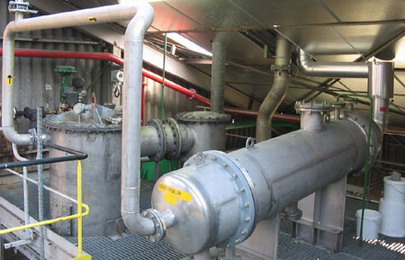Distillation model
The standard model of distillation can be used to determine atmospheric emission for following operations:
- Solvent recovery (waste cleaning solvents for example) collected from various processes,
- Heating up to boiling point on process installations (reactor, vessels, etc…) for working with liquid reflux or for standard distillation.
For distillation emissions modeling, it is also necessary to consider the other emission steps (other specific models proposed by Envmodels can be used):
- Filling distillation installation or reactors were products are heated to raise the boiling point temperature (charging model application),
- Recovering distillate (outlet of condenser) in a receiving vessel (charging model application),
- Etc…
Following picture presents a condenser used for working with liquid reflux on a production reactor.

Distillation model is based on the following assumptions:
- All of the air (or non-condensable gas) in the vessel headspace at the initial temperature has been expelled when the liquid begins to boil,
- The heated vapours leaving the installation pass through a condenser,
- Air leaving the condenser is saturated with VOC vapours at the exit gas temperature of the condenser,
- While the liquid in the vessel is boiling, emissions are assumed to be zero (only VOC vapour is expelled from the vessel and it all condenses in the condenser).
Example:
An industrial process is used for distillation recovery of waste toluene. The number of treatment operations is 50 per year.
For each batch the conditions are:
- 2 m3 of toluene (at 20°C) are distillated in a 4 m3 reactor with an overhead condenser installation,
- 1.8 m3 of purified toluene are collected during the operation,
- The condenser has an outlet vent temperature of 20°C.
Calculated emissions of toluene emitted from the process system during distillation step are:
- 0.22 kg of toluene per batch,
- 11 kg of toluene per year.
Emission from other steps (charging waste toluene in distillation vessel and recovering distillate in a receiving vessel) can also be calculated by application of standard loading model proposed by Envmodels (saturation factor is 1.45):
- Charging 2 m3 of waste toluene in reactor: 0.319 kg,
- Collecting 1.8 m3 of purified toluene in receiving vessel: 0.287 kg.
Thus, yearly emissions for all distillation process are: 41 kg of toluene
- EPA. 1994. Control of Volatile Organic Compound Emissions from Batch Processes - Alternate Control Techniques. U.S. Environmental Protection Agency, Office of Air Quality Planning and Standards, EPA-453/R-93-017.
- Crowl, Daniel and Louvar, Joseph. 2002. Chemical Process Safety, Fundamentals with Applications. Second Edition.
- EIIP. 2007. Methods for Estimating Air Emissions from Chemical Manufacturing Facilities Chapter 16 in EIIP Volume II.



